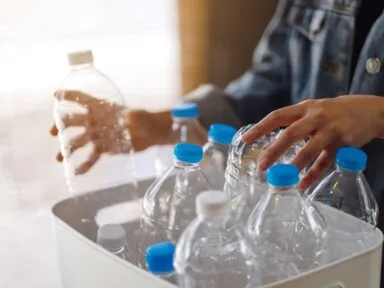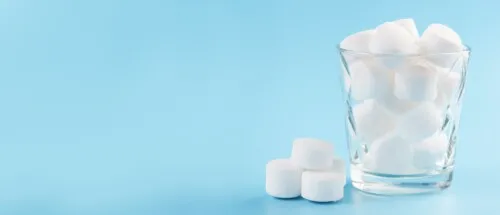Since the 1970s, plastic bottles have dominated as containers for water, soda, milk, and other beverages. These disposable bottles are widely available and convenient, but they also contribute to daily plastic waste, polluting the planet and expending natural resources.
So, exactly how many plastic bottles are used each day? Nationally, more than 100 million. Globally, more than a billion. Here’s what you need to know about the massive scale of waste that plastic bottles create, their environmental impact, and the plastic-free alternatives available.
In this article:
Overview of Daily Plastic Bottle Usage
The US leads the world in overall plastic waste and is the second-highest consumer of plastic water bottles. The country consumes about 50 billion plastic water bottles per year, averaging about 137 million per day and accounts for 10% of global water bottle usage.
Regional and Global Usage
The US and UK lead the world in plastic waste per person, but plastic use varies globally and regionally depending on several f factors. Rural areas tend to generate less plastic waste than urban places but lack the waste management resources to properly dispose of or recycle plastic.
While developing nations generally produce less plastic waste than developed countries, they are frequently burdened with imported plastic waste from wealthier nations.
Industry-Specific Demand
Unfortunately, the convenience and supply of plastic bottles continue to drive waste, in part because of bottled water and soda companies. Since their rise in popularity in the 1970s and 1980s, plastic bottles have contributed to a rapid increase in plastic waste, with no signs of slowing down.
While you can find boxed water and disposable aluminum bottles, these more eco-friendly options remain less accessible than disposable plastic bottles.
Environmental Impacts of Plastic Bottles
The convenience of plastic bottles comes at a steep environmental cost, contributing significantly to pollution and resource depletion. From overflowing landfills, littering marine ecosystems with microplastics, and increasing our carbon footprint, plastic bottles have already caused irreversible harm to our planet.
Pollution and Waste
A study in ScienceAdvances estimates that 79% of all the plastic ever made is either in a landfill or polluting the environment, the latter of which is about 20 million metric tons of plastic per year, according to The International Union for Conservation of Nature. Even in landfills, plastic can cause harm to the environment, infiltrating the soil, water, and food chain.
Effects on Marine Life
Over time, tiny plastic particles called microplastics have contaminated nearly every part of the Earth’s ecosystems, particularly marine life. Microplastics can be detrimental to animal development, reproduction, and immunity, according to the National Oceanic and Atmospheric Administration. But it’s not just wildlife at risk—contaminated water can also pose risks to human health. Exposure to pollutants from plastic waste may contribute to various water contamination symptoms, including gastrointestinal issues, skin irritation, and long-term health concerns.
Carbon Footprint
Beyond plastic waste itself, the production and transportation of plastic bottles significantly contribute to carbon emissions. Nearly all plastic is created using nonrenewable fossil fuels, emitting carbon dioxide during the process. In the US alone, the amount of fuel used to produce plastic bottles is enough to power 1.3 million cars for the year, according to Habits of Waste.
Alternatives to Plastic Bottles
Fortunately, alternative options exist to decrease plastic bottle waste and its negative impact on the environment. From reusable bottles you can use at home or at water fountains to biodegradable packaging, innovative solutions are emerging to stay hydrated without contributing to plastic waste. By switching to a reusable or disposable alternative, you could save as many as 156 bottles per year from ending up in a landfill or a natural ecosystem.
Reusable Options
Reusable water bottles come in a variety of forms and materials, including stainless steel, glass, and BPA-free plastics. Glass bottles can be reused an infinite number of times, but you’ll want to replace your stainless steel bottle every few years, and plastic reusable bottles within a year.
Reverse Osmosis
Installing a Reverse Osmosis (RO) system under your kitchen sink helps provide purified water for your whole family, so you don’t have to rely on plastic water bottles for purified water. Instead, you can fill your reusable water bottles with purified water from your RO system. Since RO can strip minerals from water like potassium and calcium, adding a remineralization cartridge to your RO system can restore these vital nutrients.
Biodegradable Materials
In recent years, you may have noticed more recyclable, compostable, and biodegradable water bottle options in stores, made from materials like paper and PLA. PLA or polylactic acid is a plant-based plastic alternative made with corn, sugarcane, and other renewable resources.
Packaging Innovations
With the growing rate of plastic waste, many bottle producers have turned to unique packaging innovations to lessen or eliminate plastic use, such as biodegradable alternatives made with algae or edible water pods. While not yet mainstream, these innovations mark a promising shift toward a plastic-free future.
Reusable Alternatives Are Key for Reducing Plastic
Since plastic water bottles became commonplace in the twentieth century, landfills have overflowed, plastic has polluted oceans, and the environment has been infiltrated by countless microplastics. Plastic waste has done irreversible damage to the Earth, much of it due to the prevalence of plastic bottles. As the global producer of plastic waste, it’s more important than ever that we turn to reusable alternatives for environmental sustainability.
One way to commit to using fewer plastic bottles is to fill reusable water bottles with purified water from home. Installing a water purification system provides you with cleaner, safer drinking water, and helps reduce waste in the world.
Learn more about Leaf Home Water Solutions
FAQs
More than 1.3 billion plastic bottles are consumed worldwide every day.
Plastic waste in water sources harms marine life, from issues with development to reproduction.
Glass, stainless steel, and plastic reusable water bottles are all affordable alternatives to disposable plastic bottles.
Yes, biodegradable water bottles are effective because they eliminate the need for plastic bottles.




